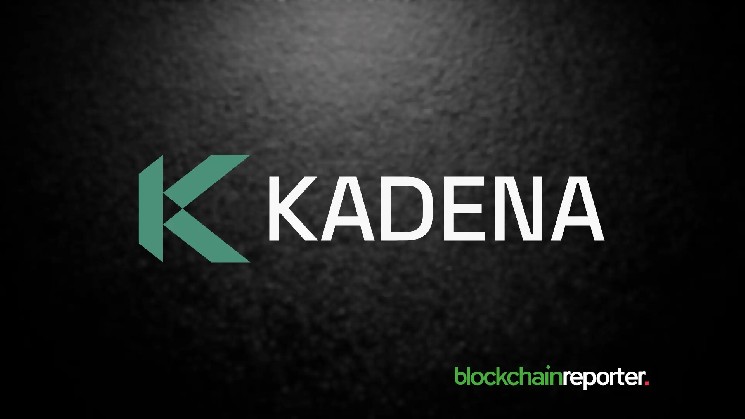Kadena, a well-known public L1 blockchain that utilizes Chainweb architecture for DeFi protocol deployment, RWA tokenization, and AI-led application integration, has released a new report focusing on RWA tokenization standards. According to the report, Kadena has identified ERC-3643 as the leading compliance-ready standard for real-world asset (RWA) tokenization.
Furthermore, the report underscores the importance of efficient, compliance-ready protocols as financial institutions increasingly adopt blockchain technology for asset tokenization.
Kadena Identifies ERC-3643 as Top Compliance-Ready Standard for RWA Tokenization
The report from Kadena highlights a shift away from traditional ERC-721 and ERC-20 standards, which lack the compliance features that institutions require. As a result, institutions are favoring the ERC-3643 standard for RWA tokenization due to its built-in AML/KYC checks, programmable compliance, jurisdictional controls, and investor accreditation.
According to the report, ERC-3643 is being extensively used to tokenize over $32 billion worth of assets. Kadena predicts that the tokenized asset sector could reach a value between $2 trillion and $11 trillion by 2030, driven primarily by institutions adopting compliance-first infrastructure. Stuart Popejoy, Kadena’s Founder, emphasizes the crucial role of compliance and standards like ERC-3643 in institutional adoption.
Kadena Introduces New RWA Token Standard Inspired by ERC-3643 with $25M Backing
In addition to endorsing ERC-3643, Kadena is developing a separate Real-World Assets (RWA) token standard using parallel-chain architecture and Pact smart contract language. Supported by a substantial $25 million fund, the new token standard prioritizes security and scalability. It also mirrors the compliance features of ERC-3643, with the real estate fund “CurveBlock” already adopting it.
As per Kadena’s report, ERC-3643 stands out as the preferred standard for compliance-ready RWA tokenization. With the RWA sector expanding rapidly, institutions are flocking to this space with a focus on compliance for secure operations. The report concludes that compliance-led standards are essential for paving the way for the future of institutional finance on blockchain.
Insightful Interview with Annelise Osborne, Chief Business Officer at Kadena
In an interview with Annelise Osborne, Chief Business Officer at Kadena, we delved deeper into the report and Kadena’s perspective on RWA tokenization. The interview sheds light on the core objectives, compliance aspects, adoption trends, and tokenization initiatives undertaken by Kadena.
Q. What sets ERC-3643 apart from ERC-20 and ERC-721 for RWA tokenization?
A. ERC-20 and ERC-721 served as foundational token standards on the Ethereum blockchain, with ERC-20 remaining the base layer for various tokens. ERC-721, introduced shortly after, specializes in non-fungible tokens (NFTs) representing unique assets like art or collectibles. In contrast, ERC-3643 was developed to offer enhanced functionality, akin to an ERC-20 token tailored for securities. It incorporates essential features such as KYC/AML verification, investor accreditation checks, and jurisdiction-specific restrictions within the token contract. This embedded compliance is particularly valuable from an institutional standpoint, making ERC-3643 a preferred choice for RWA tokenization.
ERC-3643’s integration of compliance measures directly into the token contract signifies a significant advancement in the tokenization space, aligning with the broader goal of building more efficient and secure capital markets through blockchain technology.
Q. How crucial is compliance in bridging institutional players to RWA tokenization?
A. Compliance plays a pivotal role in safeguarding investors and ensuring market efficiency. For institutional adoption of digital assets, robust compliance measures are indispensable. Regulatory clarity, especially in major jurisdictions like the United States, is essential to instill confidence in financial institutions seeking to engage with digital assets. Clear and unambiguous regulatory guidelines are vital for institutions managing substantial assets, as they prioritize regulatory certainty to mitigate risks.
The global regulatory landscape is evolving, presenting opportunities for collaboration between tech innovators and compliance experts to elevate blockchain to institutional-grade standards. The convergence of technological innovation and regulatory compliance is instrumental in bridging the gap between traditional finance and blockchain-powered solutions.
Q. How do Kadena’s RWA tokenization standards differentiate themselves from others in the market?
A. Kadena’s unique positioning stems from its foundational expertise in both innovation and institutional-grade infrastructure. Drawing on the established ERC-3643 protocol, Kadena’s RWA token standard not only adheres to compliance requirements but also addresses liquidity and accessibility challenges in asset markets. The emphasis on scalability and security, underpinned by a proof-of-work mechanism distributed across a network of chains, ensures robust protection against potential threats without compromising environmental sustainability.
By combining innovative technology with institutional-grade infrastructure, Kadena aims to revolutionize capital markets by offering efficient, secure, and scalable solutions for tokenization. The focus on real-world applicability and market liquidity sets Kadena apart as a trailblazer in the evolving landscape of RWA tokenization.
Q. Apart from Kadena’s initiatives, what additional factors are essential for driving the RWA tokenization market towards exponential growth by 2030?
A. Beyond Kadena’s contributions to the ecosystem, several critical factors are instrumental in shaping the future trajectory of RWA tokenization. Firstly, regulatory clarity remains paramount, necessitating unequivocal guidelines across major jurisdictions to facilitate institutional participation in digital asset markets. The push for regulatory certainty, coupled with proactive engagement with regulators and policymakers, is essential for fostering a conducive environment for blockchain innovation.
Secondly, education plays a crucial role in promoting widespread understanding of blockchain technology’s benefits and applications in capital markets. Bridging the knowledge gap between industry stakeholders, regulators, and the general public is vital for driving adoption and acceptance of blockchain solutions in financial ecosystems.
Lastly, interoperability emerges as a key enabler for seamless connectivity within the blockchain and crypto ecosystem, as well as between traditional financial systems and blockchain platforms. Establishing robust interoperability standards and infrastructure is essential for unlocking the full potential of tokenization and facilitating frictionless asset transfer across diverse platforms and markets.
As the industry approaches a tipping point marked by increasing institutional adoption and regulatory advancements, the projected growth of the tokenization market reflects a fundamental shift towards more efficient and inclusive financial systems. The convergence of technological innovation, regulatory clarity, and market interoperability signals a transformative phase in the evolution of finance, paving the way for a digital-first era characterized by enhanced capital market efficiency and accessibility.

